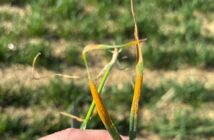Continued hot weather means cereal crops face a high risk of BYDV infection this season. Last year proved the worst incidence for over 50 years of records in many areas, to leave a legacy of inoculum now being spread by aphids.
Furthermore, large numbers of the key aphid species responsible for BYDV spread have been identified on the rapidly emerging green bridge on stubbles.
Background levels of BYDV has been building up over recent years, compounded last year by the mild autumn weather that extended aphid activity, according to Syngenta insecticide specialist, Max Newbert.
“Warm conditions increase the numbers and movement of aphids, but also shortens the persistency of any seed treatment,” he warned. “Growers should be ready to tackle rising aphid numbers as soon as possible, to prevent early BYDV infection.
“Earlier infection will result in more severe yield effects, and increases the risk of secondary spread from initial hot-spot foci through the season. Early sown crops are most at risk, however delayed drilling – to aid blackgrass control – means crops will be slower to develop and remain at more susceptible early growth stages for longer.”
Max advised that once aphids have become infected with BYDV, they will continue to spread disease as they feed throughout their life. Rhopalosiphum padi (Bird cherry oat aphid) and Sitobion avenae (Grain aphid) are the primary vectors growers should be looking to control as quickly as possible to prevent transmission.
“Fast knock-down of aphids is important to stop feeding activity and prevent further virus spread,” he advocated. “The UV stability of Hallmark Zeon, provided by its titanium dioxide formulation, is especially valuable to maintain better persistence and effective results in bright, sunny autumn conditions.
“Insecticides with poor persistency can offer little protection just days after application; aphid activity quickly resumes and crops will require retreatment.”
In trials, Hallmark Zeon was still giving better control of aphids seven days after application, compared to results that other pyrethroids achieved just three days after treatment – providing more cost-effective control and reducing the risk of potential BYDV infection.
Max also recommended that Hallmark Zeon should always be used at the full rate of 50 ml/ha. “Field trials and lab research indicates even Grain aphid with KDR resistance remain susceptible to full rate treatment; whilst reduced rate applications achieved a lower level of kill and increased risk of resistance developing. Independent resistance monitoring has shown no pyrethroid resistance among populations of Bird cherry oat aphid,” he added.
Numbers of Bird cherry oat aphid are currently the highest of all aphid species according to aphid monitoring results, and they were found at every monitoring site across the UK. Grain aphid populations were also above the seasonal average for most monitoring sites.
Top Tips for BYDV control:
• Break the green bridge
• Consider delayed sowing in high risk areas
• Monitor crops for first signs of aphid activity, indicating when seed treatment protection has run out
• Treat with Hallmark Zeon for fast knockdown and persistent results
• Always use Hallmark Zeon at full application rate of 50ml/ha



